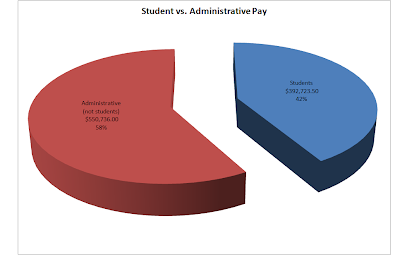Friday, April 24, 2009
This is a Student Government? Part 2.5
My, what a difference two years can make.
Below is a chart showing ASUN's spending by category from Fiscal Year 2008 (2007-2008). The data is from the Student Government Association Financial Reports for Fiscal Year 2008, available here. These data are publicly available but it does take a little digging and some time distilling into usable and interesting information.
About half of ASUN's spending in FY08 went to paying people. The next chart shows the how much of that salary chuck of the pie went to students vs. faculty.

How Does ASUN Compare to UNLV
One would expect the two university's undergraduate student governments to be roughly equivalent in terms of wage spending. Using FY08 data, below is CSUN's (UNLV's undergraduate student government) spending by category.
Ouchie! CSUN spent $147,766 less on professional staff than ASUN did.
In FY08, UNLV had nearly 22,000 undergraduates (link); UNR had 12,660 (link). How is it that UNR, with nearly 10,000 fewer undergraduates, needs to spend 1.7 times what UNLV does on adminstratative staff?
An anonymous commenter on our last post stated "the university will not allow ASUN to exist without what they deem as proper advisement and some form of university oversight." So, answer me this: why does UNR's undergrad student government need practically triple the staff UNLV's undergrad student government does (considering UNR has 10,000 fewer students)?
I see a few possibilities:
- CSUN is grossly understaffed with professionals
- ASUN has become grossly bloated with professional staff
- CSUN is much more efficient with its staff than ASUN is





The internal structure of ASUN is completely different from CSUN. UNLV has a entirely different department to deal with clubs & organizations....UNR does not. At UNLV, CSUN simply allocates something similar to club funding to the clubs and the University has an entire staff that advises and works with them. If you want to compare apples to apples, you need to factor in the staff costs for their SORCE program (http://getinvolved.unlv.edu/studentorgs/resources/). I personally think the system at UNR is better because ASUN has more control over club advising and has more autonomy from the administration.
ReplyDeleteYour point actually reinforces Lupus' argument. The department you're talking about does a lot more than just advise clubs. It also advises Greeks and runs leadership programs.
ReplyDeleteA consequence of this faculty growth within ASUN is that the student's government money (tax revenue) is being used to support things that might not be best as a part of ASUN.
If the UNR wants to support leadership programs, it should be able to defend that stance to the Regents and get funding for it.
Probably the most important argument that can be made for curbing growth is that faculty and grad students are being hired to do jobs students could do.
Running campus escort might be challenging, but there's no reason a student couldn't handle creating a schedule and tracking usage.
Also, consider this: The assistant director of Student Activities (for Programming) is a $57,000/year position. Programming will spend about $138K including Homecoming next year. The cost of the advisor is equivalent to over 40% of what ASUN spends on programming. For C&O it is $57K:$120K.
You can argue that UNLV does things differently and the numbers don't get down to it, but just looking at ASUN independently, I find it hard to believe anyone can justify spending over 1/3 of the ASUN budget on administrative faculty.
To be more clear, I am only concerned with student government spending. The students are empowered, with the Regents' approval, to essentially tax themselves through a student government fee.
ReplyDeleteTo me, it's a big problem that 38 percent of ASUN's total budget is tied down with financing administrative functions that at UNLV are picked up by the university. I recognize that in the end, students pay for it all through the per-credit fee, but students do not have direct control over the Activities & Programs portion of the fee, which I assume is what pays for UNLV's Student Involvement and Activities Department (BoR registration fee distributions.
I don't care about what the students do not have direct control over. The students do have direct control over the student government fee: how much it is (with BoR approval), how to spend it, etc. When a larger proportion of that fee is tied up at UNR, that is a problem.
It's a fair point that the two universities are structured differently, but not really relevant to my point. The fact that ASUN pays for things that UNLV pays for at that campus is a strong point in favor of change.